MGMT3021 Case Study: Analyzing Mahatma Gandhi's Leadership Approach
VerifiedAdded on 2022/11/07
|12
|3435
|396
Case Study
AI Summary
This case study delves into the transformational leadership style of Mahatma Gandhi, analyzing his effectiveness in leading the Indian independence movement. The assignment begins with an introduction highlighting the critical role of leaders in organizations and the specific focus on team leadership. It examines Gandhi's leadership through the lens of transformational leadership, emphasizing his ability to motivate followers and inspire change. The study explores Gandhi's traits, including his commitment to non-violence, strategic thinking, discipline, and ethical considerations. An analysis of his strengths and weaknesses is provided, along with an evaluation of the transformational leadership theory. The study also discusses enabling conditions for effective team leadership, such as compelling direction, strong structure, supportive context, and a shared mindset. Ethical considerations are integrated throughout, and the study concludes with an assessment of the chosen theory's usefulness in understanding effective leadership, offering valuable insights into Gandhi's impact and leadership approach.

Title Goes Here 1
TITLE OF THE PAPER CENTERED AND IN CAPS LOCK
by Student’s Name
Code + Course Name
Professor’s Name
University Name
City, State
Date
TITLE OF THE PAPER CENTERED AND IN CAPS LOCK
by Student’s Name
Code + Course Name
Professor’s Name
University Name
City, State
Date
Paraphrase This Document
Need a fresh take? Get an instant paraphrase of this document with our AI Paraphraser
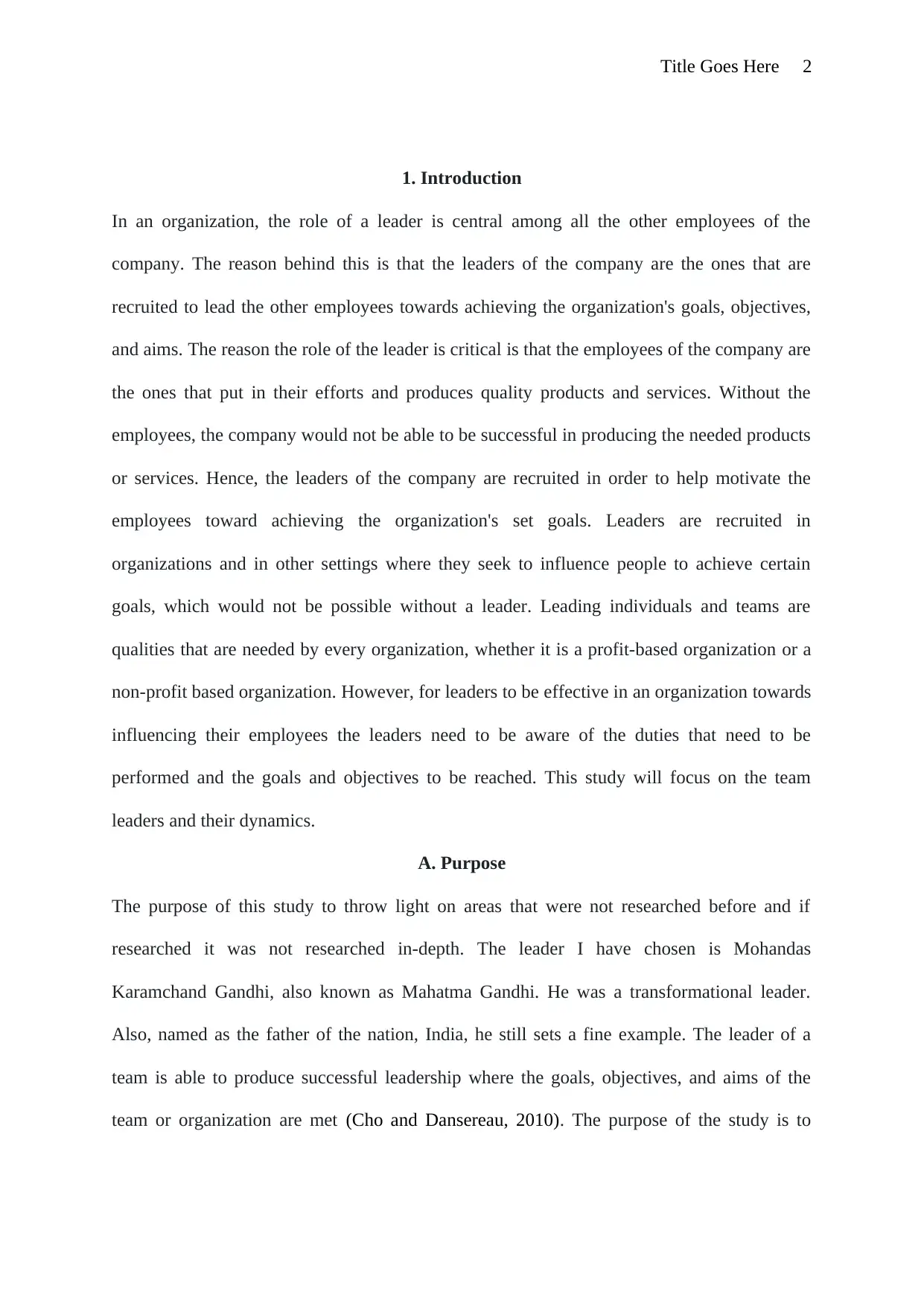
Title Goes Here 2
1. Introduction
In an organization, the role of a leader is central among all the other employees of the
company. The reason behind this is that the leaders of the company are the ones that are
recruited to lead the other employees towards achieving the organization's goals, objectives,
and aims. The reason the role of the leader is critical is that the employees of the company are
the ones that put in their efforts and produces quality products and services. Without the
employees, the company would not be able to be successful in producing the needed products
or services. Hence, the leaders of the company are recruited in order to help motivate the
employees toward achieving the organization's set goals. Leaders are recruited in
organizations and in other settings where they seek to influence people to achieve certain
goals, which would not be possible without a leader. Leading individuals and teams are
qualities that are needed by every organization, whether it is a profit-based organization or a
non-profit based organization. However, for leaders to be effective in an organization towards
influencing their employees the leaders need to be aware of the duties that need to be
performed and the goals and objectives to be reached. This study will focus on the team
leaders and their dynamics.
A. Purpose
The purpose of this study to throw light on areas that were not researched before and if
researched it was not researched in-depth. The leader I have chosen is Mohandas
Karamchand Gandhi, also known as Mahatma Gandhi. He was a transformational leader.
Also, named as the father of the nation, India, he still sets a fine example. The leader of a
team is able to produce successful leadership where the goals, objectives, and aims of the
team or organization are met (Cho and Dansereau, 2010). The purpose of the study is to
1. Introduction
In an organization, the role of a leader is central among all the other employees of the
company. The reason behind this is that the leaders of the company are the ones that are
recruited to lead the other employees towards achieving the organization's goals, objectives,
and aims. The reason the role of the leader is critical is that the employees of the company are
the ones that put in their efforts and produces quality products and services. Without the
employees, the company would not be able to be successful in producing the needed products
or services. Hence, the leaders of the company are recruited in order to help motivate the
employees toward achieving the organization's set goals. Leaders are recruited in
organizations and in other settings where they seek to influence people to achieve certain
goals, which would not be possible without a leader. Leading individuals and teams are
qualities that are needed by every organization, whether it is a profit-based organization or a
non-profit based organization. However, for leaders to be effective in an organization towards
influencing their employees the leaders need to be aware of the duties that need to be
performed and the goals and objectives to be reached. This study will focus on the team
leaders and their dynamics.
A. Purpose
The purpose of this study to throw light on areas that were not researched before and if
researched it was not researched in-depth. The leader I have chosen is Mohandas
Karamchand Gandhi, also known as Mahatma Gandhi. He was a transformational leader.
Also, named as the father of the nation, India, he still sets a fine example. The leader of a
team is able to produce successful leadership where the goals, objectives, and aims of the
team or organization are met (Cho and Dansereau, 2010). The purpose of the study is to
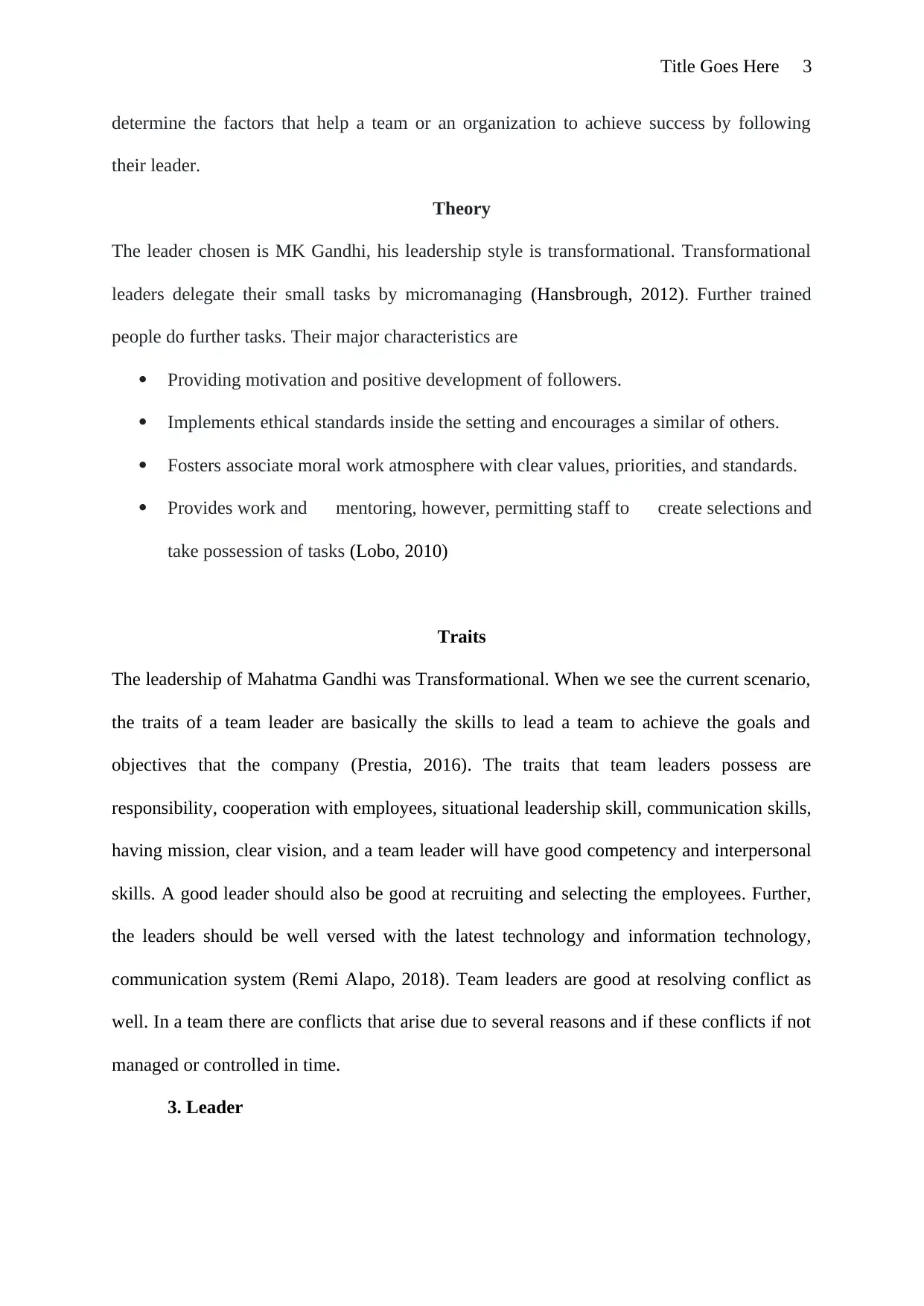
Title Goes Here 3
determine the factors that help a team or an organization to achieve success by following
their leader.
Theory
The leader chosen is MK Gandhi, his leadership style is transformational. Transformational
leaders delegate their small tasks by micromanaging (Hansbrough, 2012). Further trained
people do further tasks. Their major characteristics are
Providing motivation and positive development of followers.
Implements ethical standards inside the setting and encourages a similar of others.
Fosters associate moral work atmosphere with clear values, priorities, and standards.
Provides work and mentoring, however, permitting staff to create selections and
take possession of tasks (Lobo, 2010)
Traits
The leadership of Mahatma Gandhi was Transformational. When we see the current scenario,
the traits of a team leader are basically the skills to lead a team to achieve the goals and
objectives that the company (Prestia, 2016). The traits that team leaders possess are
responsibility, cooperation with employees, situational leadership skill, communication skills,
having mission, clear vision, and a team leader will have good competency and interpersonal
skills. A good leader should also be good at recruiting and selecting the employees. Further,
the leaders should be well versed with the latest technology and information technology,
communication system (Remi Alapo, 2018). Team leaders are good at resolving conflict as
well. In a team there are conflicts that arise due to several reasons and if these conflicts if not
managed or controlled in time.
3. Leader
determine the factors that help a team or an organization to achieve success by following
their leader.
Theory
The leader chosen is MK Gandhi, his leadership style is transformational. Transformational
leaders delegate their small tasks by micromanaging (Hansbrough, 2012). Further trained
people do further tasks. Their major characteristics are
Providing motivation and positive development of followers.
Implements ethical standards inside the setting and encourages a similar of others.
Fosters associate moral work atmosphere with clear values, priorities, and standards.
Provides work and mentoring, however, permitting staff to create selections and
take possession of tasks (Lobo, 2010)
Traits
The leadership of Mahatma Gandhi was Transformational. When we see the current scenario,
the traits of a team leader are basically the skills to lead a team to achieve the goals and
objectives that the company (Prestia, 2016). The traits that team leaders possess are
responsibility, cooperation with employees, situational leadership skill, communication skills,
having mission, clear vision, and a team leader will have good competency and interpersonal
skills. A good leader should also be good at recruiting and selecting the employees. Further,
the leaders should be well versed with the latest technology and information technology,
communication system (Remi Alapo, 2018). Team leaders are good at resolving conflict as
well. In a team there are conflicts that arise due to several reasons and if these conflicts if not
managed or controlled in time.
3. Leader
⊘ This is a preview!⊘
Do you want full access?
Subscribe today to unlock all pages.

Trusted by 1+ million students worldwide

Title Goes Here 4
Gandhi is a perfect leader and an example of transformational leadership as his style
was different from the ones that existed in that era. The time was full of violence and fights
and he chose to act upon non-violence. He was against British rule and fought against it
peacefully. The leadership style suggests change and the approach used by Mahatma Gandhi
is perfectly that. Many people resist change and the quality of a successful transformational
leader is that he has the ability to motivate people to accept that change. Gandhi is a role
model for many people, especially leaders. His way of leading differs from any other. It is
under the transformational leadership style that people often outdo themselves. Gandhi is one
of the few people that helped India get freedom from British rule in his way of leading. He
had many followers. His style was appreciated and looked at surprisingly by many, he was
very kind to his enemies as well and was totally against violence.
B. Analysis using traits (strengths & weaknesses)
There are a few traits/ strengths of Mahatma Gandhi that have always intrigued the
world. Here are a few
Become The modification, we wish to see
A great leader forever leads to an exemplary life that echoes his ideals.This nationalist
leader sacrificed his thriving law practice, got inspired by Nelson Mandela, and adopted an
easy life to measure among the millions who lived in impoverishment throughout his freedom
struggle. Here are his strengths and weaknesses-
Reasonable
Even once stating that the Republic of India would be divided over his body, he realized that
partition was inevitable because the sole answer to the Hindu-Muslim divide, and accepted
it.
Strategist
Gandhi at that time was a fascinating figure. He was a beautiful planner, promoter and leader.
Gandhi is a perfect leader and an example of transformational leadership as his style
was different from the ones that existed in that era. The time was full of violence and fights
and he chose to act upon non-violence. He was against British rule and fought against it
peacefully. The leadership style suggests change and the approach used by Mahatma Gandhi
is perfectly that. Many people resist change and the quality of a successful transformational
leader is that he has the ability to motivate people to accept that change. Gandhi is a role
model for many people, especially leaders. His way of leading differs from any other. It is
under the transformational leadership style that people often outdo themselves. Gandhi is one
of the few people that helped India get freedom from British rule in his way of leading. He
had many followers. His style was appreciated and looked at surprisingly by many, he was
very kind to his enemies as well and was totally against violence.
B. Analysis using traits (strengths & weaknesses)
There are a few traits/ strengths of Mahatma Gandhi that have always intrigued the
world. Here are a few
Become The modification, we wish to see
A great leader forever leads to an exemplary life that echoes his ideals.This nationalist
leader sacrificed his thriving law practice, got inspired by Nelson Mandela, and adopted an
easy life to measure among the millions who lived in impoverishment throughout his freedom
struggle. Here are his strengths and weaknesses-
Reasonable
Even once stating that the Republic of India would be divided over his body, he realized that
partition was inevitable because the sole answer to the Hindu-Muslim divide, and accepted
it.
Strategist
Gandhi at that time was a fascinating figure. He was a beautiful planner, promoter and leader.
Paraphrase This Document
Need a fresh take? Get an instant paraphrase of this document with our AI Paraphraser
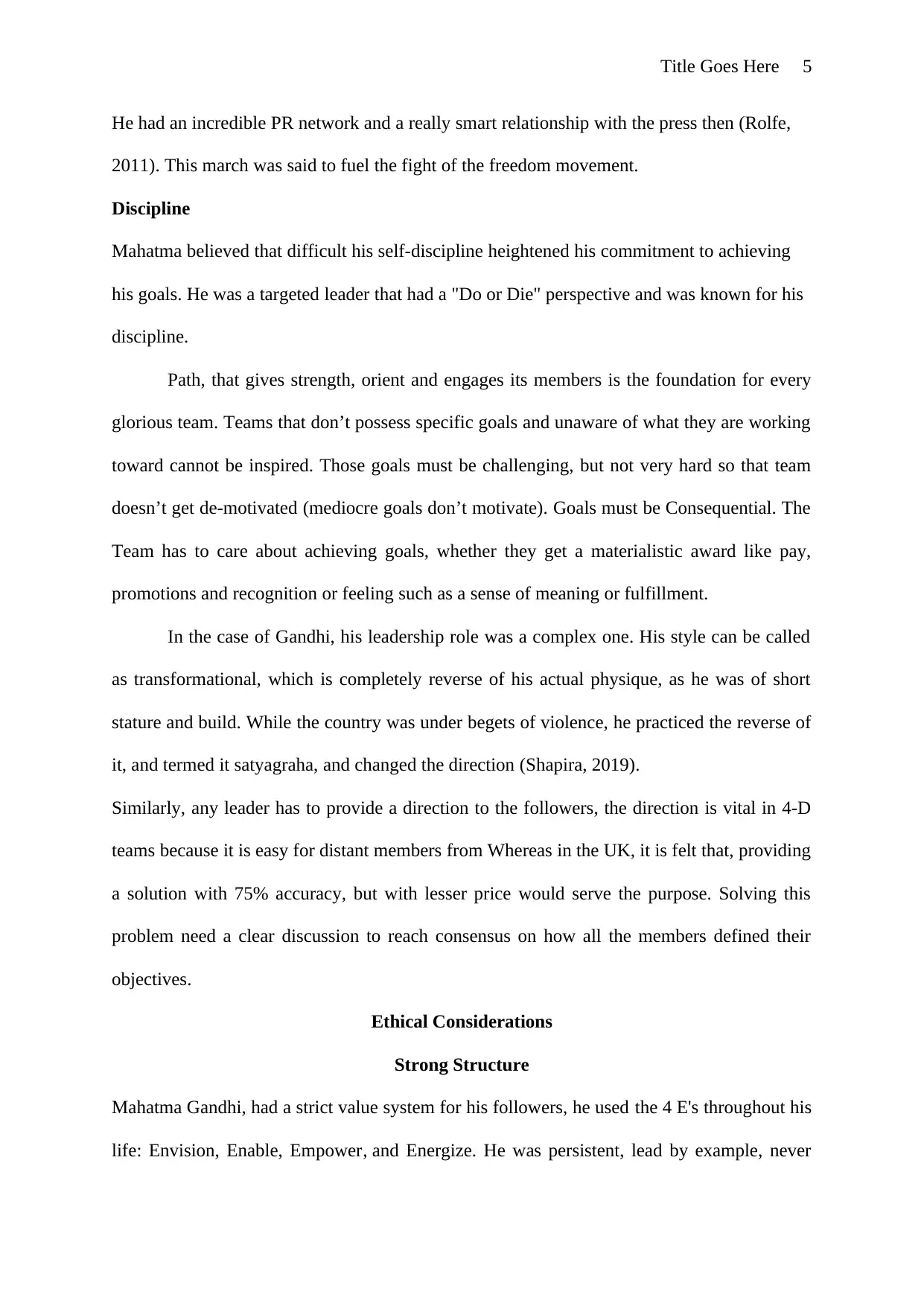
Title Goes Here 5
He had an incredible PR network and a really smart relationship with the press then (Rolfe,
2011). This march was said to fuel the fight of the freedom movement.
Discipline
Mahatma believed that difficult his self-discipline heightened his commitment to achieving
his goals. He was a targeted leader that had a "Do or Die" perspective and was known for his
discipline.
Path, that gives strength, orient and engages its members is the foundation for every
glorious team. Teams that don’t possess specific goals and unaware of what they are working
toward cannot be inspired. Those goals must be challenging, but not very hard so that team
doesn’t get de-motivated (mediocre goals don’t motivate). Goals must be Consequential. The
Team has to care about achieving goals, whether they get a materialistic award like pay,
promotions and recognition or feeling such as a sense of meaning or fulfillment.
In the case of Gandhi, his leadership role was a complex one. His style can be called
as transformational, which is completely reverse of his actual physique, as he was of short
stature and build. While the country was under begets of violence, he practiced the reverse of
it, and termed it satyagraha, and changed the direction (Shapira, 2019).
Similarly, any leader has to provide a direction to the followers, the direction is vital in 4-D
teams because it is easy for distant members from Whereas in the UK, it is felt that, providing
a solution with 75% accuracy, but with lesser price would serve the purpose. Solving this
problem need a clear discussion to reach consensus on how all the members defined their
objectives.
Ethical Considerations
Strong Structure
Mahatma Gandhi, had a strict value system for his followers, he used the 4 E's throughout his
life: Envision, Enable, Empower, and Energize. He was persistent, lead by example, never
He had an incredible PR network and a really smart relationship with the press then (Rolfe,
2011). This march was said to fuel the fight of the freedom movement.
Discipline
Mahatma believed that difficult his self-discipline heightened his commitment to achieving
his goals. He was a targeted leader that had a "Do or Die" perspective and was known for his
discipline.
Path, that gives strength, orient and engages its members is the foundation for every
glorious team. Teams that don’t possess specific goals and unaware of what they are working
toward cannot be inspired. Those goals must be challenging, but not very hard so that team
doesn’t get de-motivated (mediocre goals don’t motivate). Goals must be Consequential. The
Team has to care about achieving goals, whether they get a materialistic award like pay,
promotions and recognition or feeling such as a sense of meaning or fulfillment.
In the case of Gandhi, his leadership role was a complex one. His style can be called
as transformational, which is completely reverse of his actual physique, as he was of short
stature and build. While the country was under begets of violence, he practiced the reverse of
it, and termed it satyagraha, and changed the direction (Shapira, 2019).
Similarly, any leader has to provide a direction to the followers, the direction is vital in 4-D
teams because it is easy for distant members from Whereas in the UK, it is felt that, providing
a solution with 75% accuracy, but with lesser price would serve the purpose. Solving this
problem need a clear discussion to reach consensus on how all the members defined their
objectives.
Ethical Considerations
Strong Structure
Mahatma Gandhi, had a strict value system for his followers, he used the 4 E's throughout his
life: Envision, Enable, Empower, and Energize. He was persistent, lead by example, never
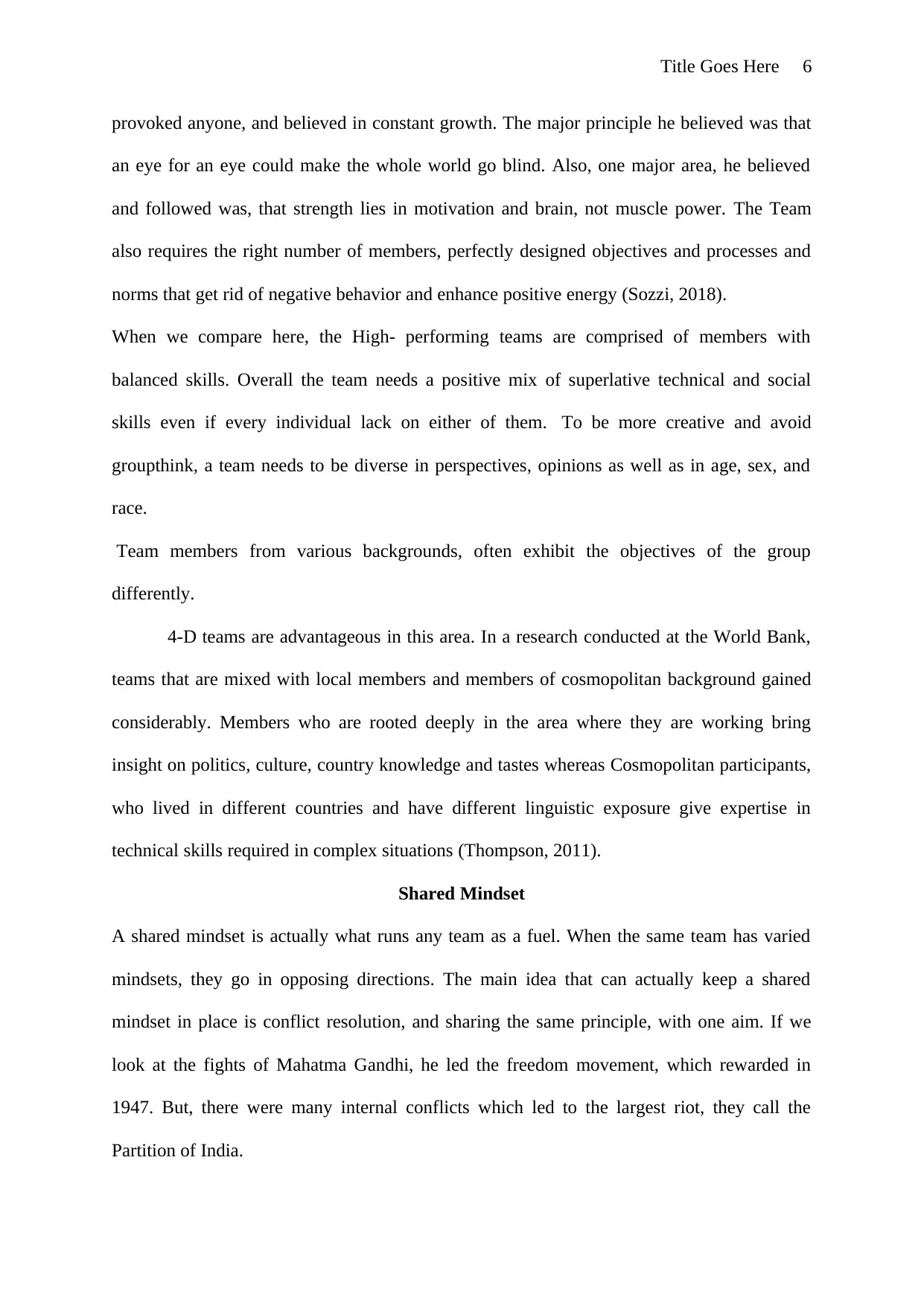
Title Goes Here 6
provoked anyone, and believed in constant growth. The major principle he believed was that
an eye for an eye could make the whole world go blind. Also, one major area, he believed
and followed was, that strength lies in motivation and brain, not muscle power. The Team
also requires the right number of members, perfectly designed objectives and processes and
norms that get rid of negative behavior and enhance positive energy (Sozzi, 2018).
When we compare here, the High- performing teams are comprised of members with
balanced skills. Overall the team needs a positive mix of superlative technical and social
skills even if every individual lack on either of them. To be more creative and avoid
groupthink, a team needs to be diverse in perspectives, opinions as well as in age, sex, and
race.
Team members from various backgrounds, often exhibit the objectives of the group
differently.
4-D teams are advantageous in this area. In a research conducted at the World Bank,
teams that are mixed with local members and members of cosmopolitan background gained
considerably. Members who are rooted deeply in the area where they are working bring
insight on politics, culture, country knowledge and tastes whereas Cosmopolitan participants,
who lived in different countries and have different linguistic exposure give expertise in
technical skills required in complex situations (Thompson, 2011).
Shared Mindset
A shared mindset is actually what runs any team as a fuel. When the same team has varied
mindsets, they go in opposing directions. The main idea that can actually keep a shared
mindset in place is conflict resolution, and sharing the same principle, with one aim. If we
look at the fights of Mahatma Gandhi, he led the freedom movement, which rewarded in
1947. But, there were many internal conflicts which led to the largest riot, they call the
Partition of India.
provoked anyone, and believed in constant growth. The major principle he believed was that
an eye for an eye could make the whole world go blind. Also, one major area, he believed
and followed was, that strength lies in motivation and brain, not muscle power. The Team
also requires the right number of members, perfectly designed objectives and processes and
norms that get rid of negative behavior and enhance positive energy (Sozzi, 2018).
When we compare here, the High- performing teams are comprised of members with
balanced skills. Overall the team needs a positive mix of superlative technical and social
skills even if every individual lack on either of them. To be more creative and avoid
groupthink, a team needs to be diverse in perspectives, opinions as well as in age, sex, and
race.
Team members from various backgrounds, often exhibit the objectives of the group
differently.
4-D teams are advantageous in this area. In a research conducted at the World Bank,
teams that are mixed with local members and members of cosmopolitan background gained
considerably. Members who are rooted deeply in the area where they are working bring
insight on politics, culture, country knowledge and tastes whereas Cosmopolitan participants,
who lived in different countries and have different linguistic exposure give expertise in
technical skills required in complex situations (Thompson, 2011).
Shared Mindset
A shared mindset is actually what runs any team as a fuel. When the same team has varied
mindsets, they go in opposing directions. The main idea that can actually keep a shared
mindset in place is conflict resolution, and sharing the same principle, with one aim. If we
look at the fights of Mahatma Gandhi, he led the freedom movement, which rewarded in
1947. But, there were many internal conflicts which led to the largest riot, they call the
Partition of India.
⊘ This is a preview!⊘
Do you want full access?
Subscribe today to unlock all pages.

Trusted by 1+ million students worldwide

Title Goes Here 7
In the past, a permanent set of homogenous members performed directly face to face
possessing a similar mindset. That’s not a case now, teams often behave themselves as not a
single cohesive group but various smaller subgroups.
Evaluating Theory
To be a decent leader one should be skillful, else no one would understand the point. This can
be conjointly why the majority notice it easier to be managers. Management is
often educated. Leadership should be cultivated. Mahatma Gandhi suffered years in jail and
other atrocities before he could gain a cult following. He said, "A 'No' expressed from the
deepest conviction is healthier than a 'Yes' simply uttered to please, or worse, to
avoid bother." A manager would attempt to please so as to diffuse a scenario. A
pacesetter won't worry regarding making a scenario. The team effectiveness or efficacy is
based on having the right support which is the third condition. This includes a good
performance reinforced by holding a reward system, just like data required for the work that
can be accessed by an information system, training offered by an education system and
protecting material resources like funding and technical assistance required to do a job. No
team ever gets all their requirements, the leaders can manage problems by taking the time to
get the necessary requirements appropriately in place from the beginning.
The teams that scattered geographically and digitally dependent may often find
difficult in terms of supportive context as the resources available may differ a lot for the team
members.
A review of groupthink
Janis in 1972 described groupthink as “mode of thinking that people engage in when
they are deeply involved in a cohesive in-group when the members’ striving for unanimity
override their motivation to realistically appraise alternative course of action”. Therefore,
In the past, a permanent set of homogenous members performed directly face to face
possessing a similar mindset. That’s not a case now, teams often behave themselves as not a
single cohesive group but various smaller subgroups.
Evaluating Theory
To be a decent leader one should be skillful, else no one would understand the point. This can
be conjointly why the majority notice it easier to be managers. Management is
often educated. Leadership should be cultivated. Mahatma Gandhi suffered years in jail and
other atrocities before he could gain a cult following. He said, "A 'No' expressed from the
deepest conviction is healthier than a 'Yes' simply uttered to please, or worse, to
avoid bother." A manager would attempt to please so as to diffuse a scenario. A
pacesetter won't worry regarding making a scenario. The team effectiveness or efficacy is
based on having the right support which is the third condition. This includes a good
performance reinforced by holding a reward system, just like data required for the work that
can be accessed by an information system, training offered by an education system and
protecting material resources like funding and technical assistance required to do a job. No
team ever gets all their requirements, the leaders can manage problems by taking the time to
get the necessary requirements appropriately in place from the beginning.
The teams that scattered geographically and digitally dependent may often find
difficult in terms of supportive context as the resources available may differ a lot for the team
members.
A review of groupthink
Janis in 1972 described groupthink as “mode of thinking that people engage in when
they are deeply involved in a cohesive in-group when the members’ striving for unanimity
override their motivation to realistically appraise alternative course of action”. Therefore,
Paraphrase This Document
Need a fresh take? Get an instant paraphrase of this document with our AI Paraphraser
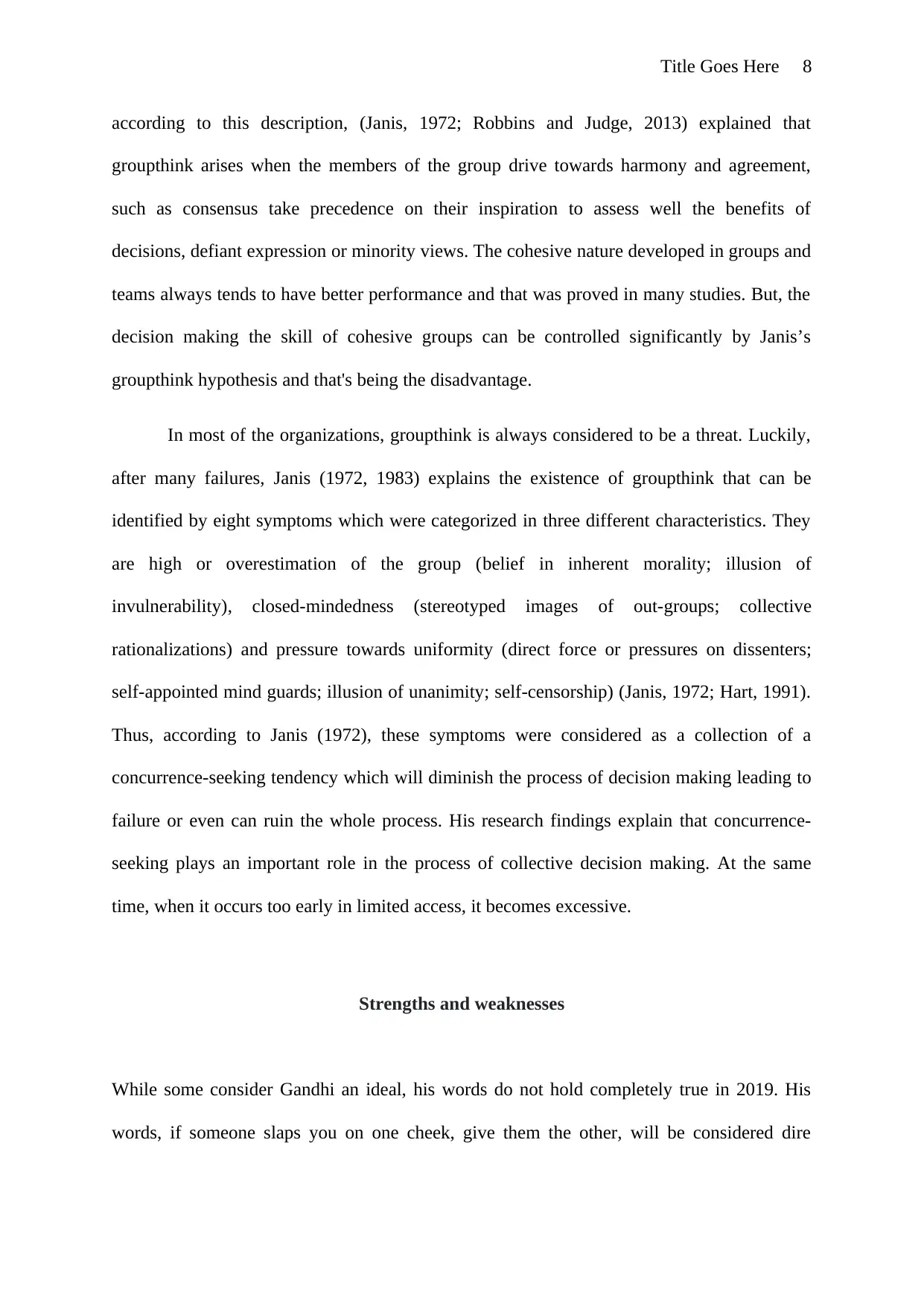
Title Goes Here 8
according to this description, (Janis, 1972; Robbins and Judge, 2013) explained that
groupthink arises when the members of the group drive towards harmony and agreement,
such as consensus take precedence on their inspiration to assess well the benefits of
decisions, defiant expression or minority views. The cohesive nature developed in groups and
teams always tends to have better performance and that was proved in many studies. But, the
decision making the skill of cohesive groups can be controlled significantly by Janis’s
groupthink hypothesis and that's being the disadvantage.
In most of the organizations, groupthink is always considered to be a threat. Luckily,
after many failures, Janis (1972, 1983) explains the existence of groupthink that can be
identified by eight symptoms which were categorized in three different characteristics. They
are high or overestimation of the group (belief in inherent morality; illusion of
invulnerability), closed-mindedness (stereotyped images of out-groups; collective
rationalizations) and pressure towards uniformity (direct force or pressures on dissenters;
self-appointed mind guards; illusion of unanimity; self-censorship) (Janis, 1972; Hart, 1991).
Thus, according to Janis (1972), these symptoms were considered as a collection of a
concurrence-seeking tendency which will diminish the process of decision making leading to
failure or even can ruin the whole process. His research findings explain that concurrence-
seeking plays an important role in the process of collective decision making. At the same
time, when it occurs too early in limited access, it becomes excessive.
Strengths and weaknesses
While some consider Gandhi an ideal, his words do not hold completely true in 2019. His
words, if someone slaps you on one cheek, give them the other, will be considered dire
according to this description, (Janis, 1972; Robbins and Judge, 2013) explained that
groupthink arises when the members of the group drive towards harmony and agreement,
such as consensus take precedence on their inspiration to assess well the benefits of
decisions, defiant expression or minority views. The cohesive nature developed in groups and
teams always tends to have better performance and that was proved in many studies. But, the
decision making the skill of cohesive groups can be controlled significantly by Janis’s
groupthink hypothesis and that's being the disadvantage.
In most of the organizations, groupthink is always considered to be a threat. Luckily,
after many failures, Janis (1972, 1983) explains the existence of groupthink that can be
identified by eight symptoms which were categorized in three different characteristics. They
are high or overestimation of the group (belief in inherent morality; illusion of
invulnerability), closed-mindedness (stereotyped images of out-groups; collective
rationalizations) and pressure towards uniformity (direct force or pressures on dissenters;
self-appointed mind guards; illusion of unanimity; self-censorship) (Janis, 1972; Hart, 1991).
Thus, according to Janis (1972), these symptoms were considered as a collection of a
concurrence-seeking tendency which will diminish the process of decision making leading to
failure or even can ruin the whole process. His research findings explain that concurrence-
seeking plays an important role in the process of collective decision making. At the same
time, when it occurs too early in limited access, it becomes excessive.
Strengths and weaknesses
While some consider Gandhi an ideal, his words do not hold completely true in 2019. His
words, if someone slaps you on one cheek, give them the other, will be considered dire
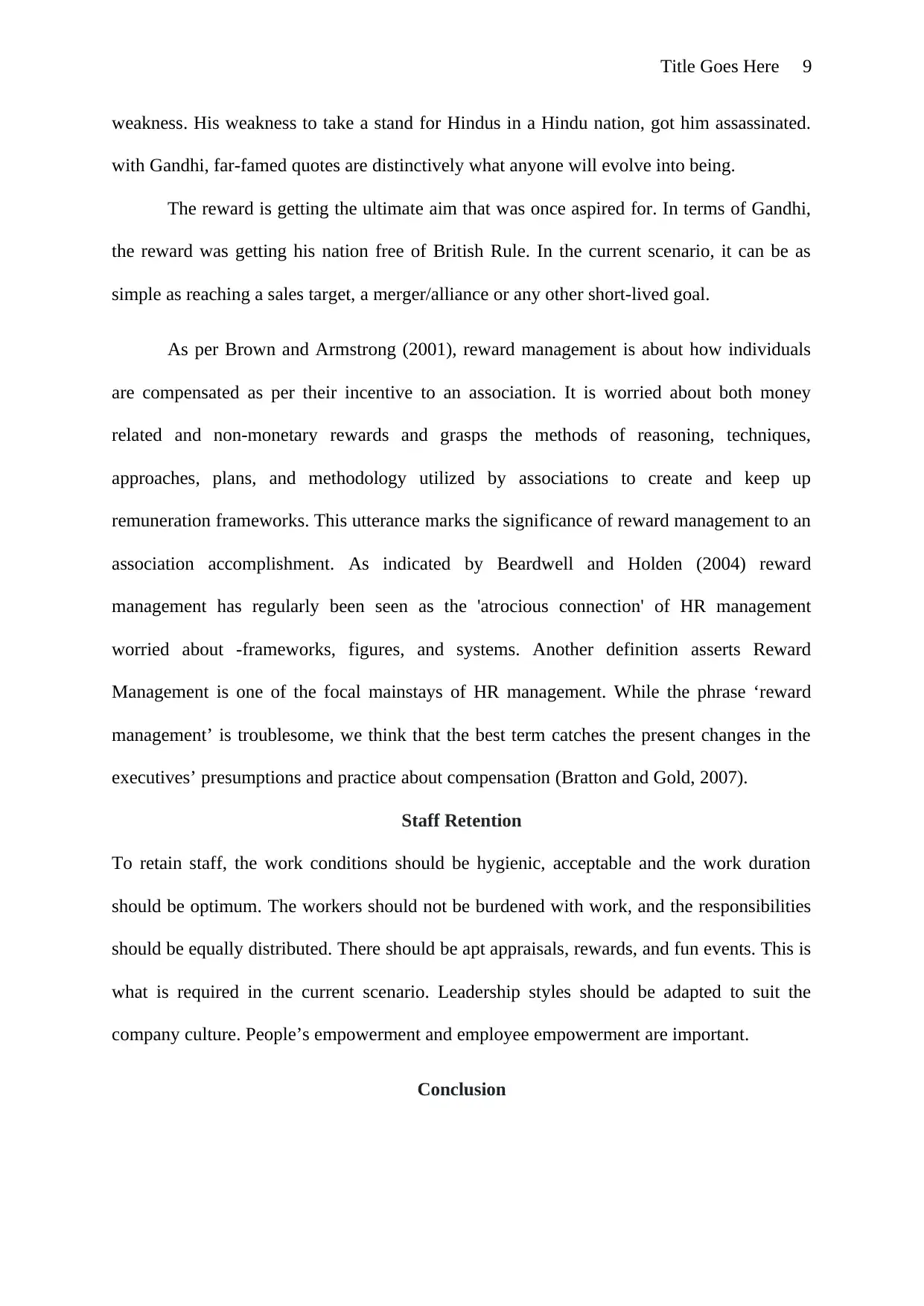
Title Goes Here 9
weakness. His weakness to take a stand for Hindus in a Hindu nation, got him assassinated.
with Gandhi, far-famed quotes are distinctively what anyone will evolve into being.
The reward is getting the ultimate aim that was once aspired for. In terms of Gandhi,
the reward was getting his nation free of British Rule. In the current scenario, it can be as
simple as reaching a sales target, a merger/alliance or any other short-lived goal.
As per Brown and Armstrong (2001), reward management is about how individuals
are compensated as per their incentive to an association. It is worried about both money
related and non-monetary rewards and grasps the methods of reasoning, techniques,
approaches, plans, and methodology utilized by associations to create and keep up
remuneration frameworks. This utterance marks the significance of reward management to an
association accomplishment. As indicated by Beardwell and Holden (2004) reward
management has regularly been seen as the 'atrocious connection' of HR management
worried about -frameworks, figures, and systems. Another definition asserts Reward
Management is one of the focal mainstays of HR management. While the phrase ‘reward
management’ is troublesome, we think that the best term catches the present changes in the
executives’ presumptions and practice about compensation (Bratton and Gold, 2007).
Staff Retention
To retain staff, the work conditions should be hygienic, acceptable and the work duration
should be optimum. The workers should not be burdened with work, and the responsibilities
should be equally distributed. There should be apt appraisals, rewards, and fun events. This is
what is required in the current scenario. Leadership styles should be adapted to suit the
company culture. People’s empowerment and employee empowerment are important.
Conclusion
weakness. His weakness to take a stand for Hindus in a Hindu nation, got him assassinated.
with Gandhi, far-famed quotes are distinctively what anyone will evolve into being.
The reward is getting the ultimate aim that was once aspired for. In terms of Gandhi,
the reward was getting his nation free of British Rule. In the current scenario, it can be as
simple as reaching a sales target, a merger/alliance or any other short-lived goal.
As per Brown and Armstrong (2001), reward management is about how individuals
are compensated as per their incentive to an association. It is worried about both money
related and non-monetary rewards and grasps the methods of reasoning, techniques,
approaches, plans, and methodology utilized by associations to create and keep up
remuneration frameworks. This utterance marks the significance of reward management to an
association accomplishment. As indicated by Beardwell and Holden (2004) reward
management has regularly been seen as the 'atrocious connection' of HR management
worried about -frameworks, figures, and systems. Another definition asserts Reward
Management is one of the focal mainstays of HR management. While the phrase ‘reward
management’ is troublesome, we think that the best term catches the present changes in the
executives’ presumptions and practice about compensation (Bratton and Gold, 2007).
Staff Retention
To retain staff, the work conditions should be hygienic, acceptable and the work duration
should be optimum. The workers should not be burdened with work, and the responsibilities
should be equally distributed. There should be apt appraisals, rewards, and fun events. This is
what is required in the current scenario. Leadership styles should be adapted to suit the
company culture. People’s empowerment and employee empowerment are important.
Conclusion
⊘ This is a preview!⊘
Do you want full access?
Subscribe today to unlock all pages.

Trusted by 1+ million students worldwide
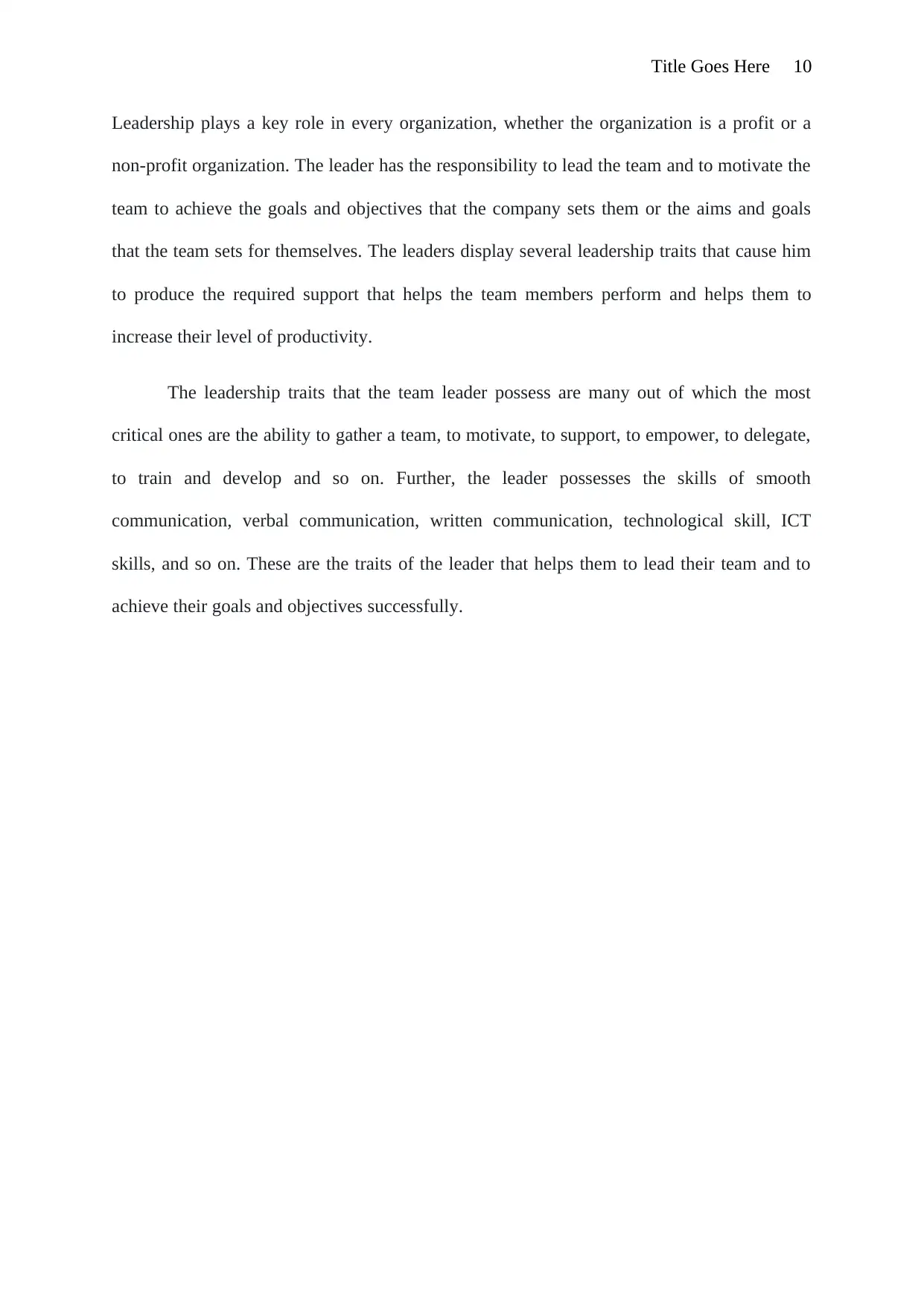
Title Goes Here 10
Leadership plays a key role in every organization, whether the organization is a profit or a
non-profit organization. The leader has the responsibility to lead the team and to motivate the
team to achieve the goals and objectives that the company sets them or the aims and goals
that the team sets for themselves. The leaders display several leadership traits that cause him
to produce the required support that helps the team members perform and helps them to
increase their level of productivity.
The leadership traits that the team leader possess are many out of which the most
critical ones are the ability to gather a team, to motivate, to support, to empower, to delegate,
to train and develop and so on. Further, the leader possesses the skills of smooth
communication, verbal communication, written communication, technological skill, ICT
skills, and so on. These are the traits of the leader that helps them to lead their team and to
achieve their goals and objectives successfully.
Leadership plays a key role in every organization, whether the organization is a profit or a
non-profit organization. The leader has the responsibility to lead the team and to motivate the
team to achieve the goals and objectives that the company sets them or the aims and goals
that the team sets for themselves. The leaders display several leadership traits that cause him
to produce the required support that helps the team members perform and helps them to
increase their level of productivity.
The leadership traits that the team leader possess are many out of which the most
critical ones are the ability to gather a team, to motivate, to support, to empower, to delegate,
to train and develop and so on. Further, the leader possesses the skills of smooth
communication, verbal communication, written communication, technological skill, ICT
skills, and so on. These are the traits of the leader that helps them to lead their team and to
achieve their goals and objectives successfully.
Paraphrase This Document
Need a fresh take? Get an instant paraphrase of this document with our AI Paraphraser
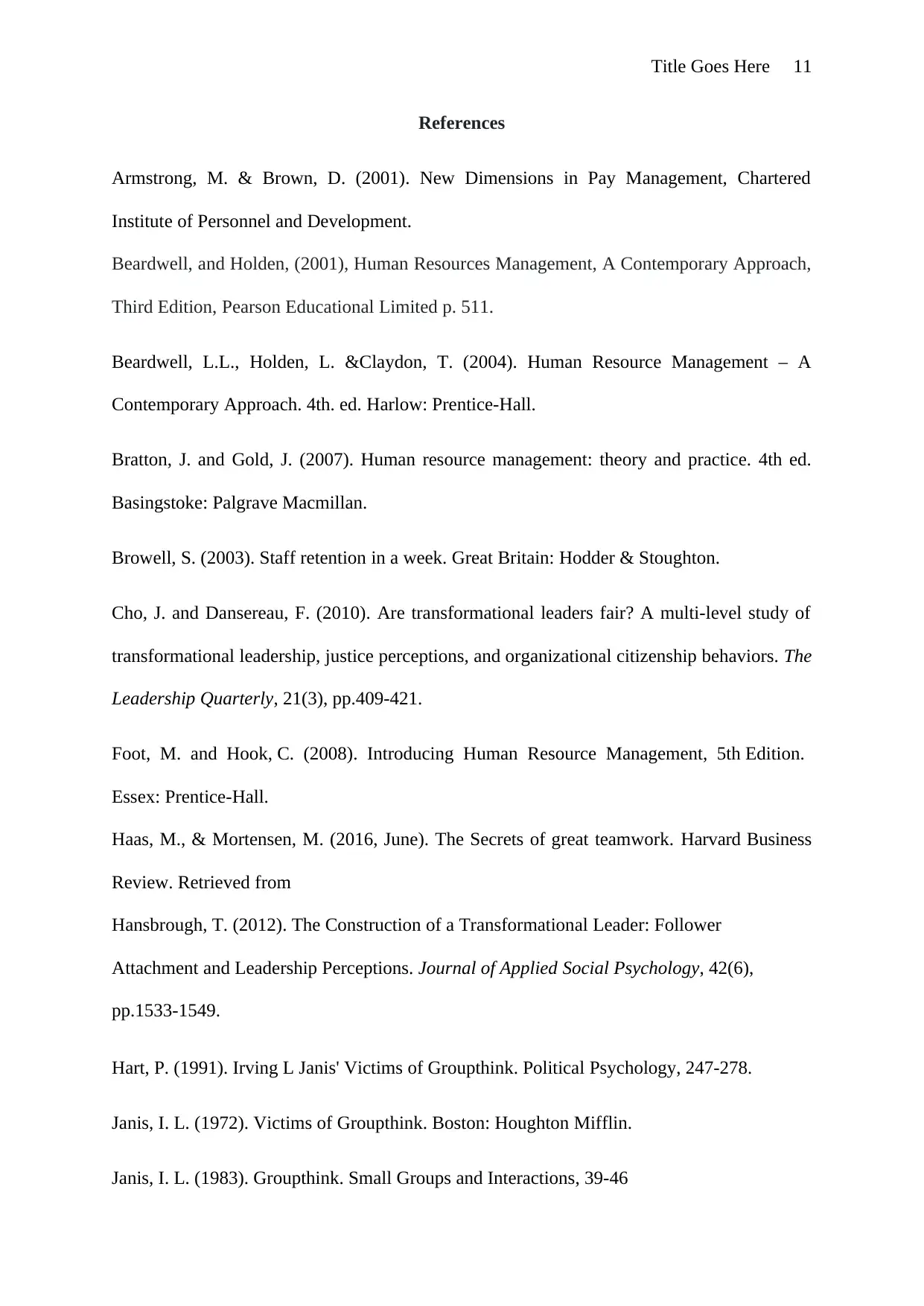
Title Goes Here 11
References
Armstrong, M. & Brown, D. (2001). New Dimensions in Pay Management, Chartered
Institute of Personnel and Development.
Beardwell, and Holden, (2001), Human Resources Management, A Contemporary Approach,
Third Edition, Pearson Educational Limited p. 511.
Beardwell, L.L., Holden, L. &Claydon, T. (2004). Human Resource Management – A
Contemporary Approach. 4th. ed. Harlow: Prentice-Hall.
Bratton, J. and Gold, J. (2007). Human resource management: theory and practice. 4th ed.
Basingstoke: Palgrave Macmillan.
Browell, S. (2003). Staff retention in a week. Great Britain: Hodder & Stoughton.
Cho, J. and Dansereau, F. (2010). Are transformational leaders fair? A multi-level study of
transformational leadership, justice perceptions, and organizational citizenship behaviors. The
Leadership Quarterly, 21(3), pp.409-421.
Foot, M. and Hook, C. (2008). Introducing Human Resource Management, 5th Edition.
Essex: Prentice-Hall.
Haas, M., & Mortensen, M. (2016, June). The Secrets of great teamwork. Harvard Business
Review. Retrieved from
Hansbrough, T. (2012). The Construction of a Transformational Leader: Follower
Attachment and Leadership Perceptions. Journal of Applied Social Psychology, 42(6),
pp.1533-1549.
Hart, P. (1991). Irving L Janis' Victims of Groupthink. Political Psychology, 247-278.
Janis, I. L. (1972). Victims of Groupthink. Boston: Houghton Mifflin.
Janis, I. L. (1983). Groupthink. Small Groups and Interactions, 39-46
References
Armstrong, M. & Brown, D. (2001). New Dimensions in Pay Management, Chartered
Institute of Personnel and Development.
Beardwell, and Holden, (2001), Human Resources Management, A Contemporary Approach,
Third Edition, Pearson Educational Limited p. 511.
Beardwell, L.L., Holden, L. &Claydon, T. (2004). Human Resource Management – A
Contemporary Approach. 4th. ed. Harlow: Prentice-Hall.
Bratton, J. and Gold, J. (2007). Human resource management: theory and practice. 4th ed.
Basingstoke: Palgrave Macmillan.
Browell, S. (2003). Staff retention in a week. Great Britain: Hodder & Stoughton.
Cho, J. and Dansereau, F. (2010). Are transformational leaders fair? A multi-level study of
transformational leadership, justice perceptions, and organizational citizenship behaviors. The
Leadership Quarterly, 21(3), pp.409-421.
Foot, M. and Hook, C. (2008). Introducing Human Resource Management, 5th Edition.
Essex: Prentice-Hall.
Haas, M., & Mortensen, M. (2016, June). The Secrets of great teamwork. Harvard Business
Review. Retrieved from
Hansbrough, T. (2012). The Construction of a Transformational Leader: Follower
Attachment and Leadership Perceptions. Journal of Applied Social Psychology, 42(6),
pp.1533-1549.
Hart, P. (1991). Irving L Janis' Victims of Groupthink. Political Psychology, 247-278.
Janis, I. L. (1972). Victims of Groupthink. Boston: Houghton Mifflin.
Janis, I. L. (1983). Groupthink. Small Groups and Interactions, 39-46

Title Goes Here 12
Lobo, V. (2010). Transformational Leadership to Promote Cross-Generational
Retention. Nursing Leadership, 23(2), pp.21-31.
Maund, L. (2001). An Introduction to Human Resource Management Theory & Practice.
Palgrave, Macmillan.
Parekh, B. (2010). Gandhi. New York: Sterling.
Pilbeam, S., &Corbridge M. (2002). People Resourcing: HRM in practice (2nd ed.). UK:
Financial times prentice hall.
Prestia, A. (2016). Transformational Resiliency. Nurse Leader, 14(5), pp.354-357.
Rajan (1997: 75). Reproduced with the permission of Eclipse Group Limited cited in
Remi Alapo (2018). Ministerial Leadership: The Servant Leader as a Transformational
Leader. Philosophy Study, 8(1).
Rolfe, P. (2011). Transformational Leadership Theory: What Every Leader Needs to
Know. Nurse Leader, 9(2), pp.54-57.
Shapira, R. (2019). High-Moral Trusting Transformational Leaders, Charismatic-
Transformational Leadership, and Charismatic Leadership. SSRN Electronic Journal.
Sozzi, R. (2018). Leadership: The Essence of Being a Mentor. Leader to Leader, 2018(89),
pp.46-50.
Thompson, E. (2011). Are you a transformational leader?. OR Nurse, 5(3), p.3.
Thorpe, R. and Homan, G. (2000) Strategic Reward Systems. 1st edn. Essex: Pearson
Education.
Lobo, V. (2010). Transformational Leadership to Promote Cross-Generational
Retention. Nursing Leadership, 23(2), pp.21-31.
Maund, L. (2001). An Introduction to Human Resource Management Theory & Practice.
Palgrave, Macmillan.
Parekh, B. (2010). Gandhi. New York: Sterling.
Pilbeam, S., &Corbridge M. (2002). People Resourcing: HRM in practice (2nd ed.). UK:
Financial times prentice hall.
Prestia, A. (2016). Transformational Resiliency. Nurse Leader, 14(5), pp.354-357.
Rajan (1997: 75). Reproduced with the permission of Eclipse Group Limited cited in
Remi Alapo (2018). Ministerial Leadership: The Servant Leader as a Transformational
Leader. Philosophy Study, 8(1).
Rolfe, P. (2011). Transformational Leadership Theory: What Every Leader Needs to
Know. Nurse Leader, 9(2), pp.54-57.
Shapira, R. (2019). High-Moral Trusting Transformational Leaders, Charismatic-
Transformational Leadership, and Charismatic Leadership. SSRN Electronic Journal.
Sozzi, R. (2018). Leadership: The Essence of Being a Mentor. Leader to Leader, 2018(89),
pp.46-50.
Thompson, E. (2011). Are you a transformational leader?. OR Nurse, 5(3), p.3.
Thorpe, R. and Homan, G. (2000) Strategic Reward Systems. 1st edn. Essex: Pearson
Education.
⊘ This is a preview!⊘
Do you want full access?
Subscribe today to unlock all pages.

Trusted by 1+ million students worldwide
1 out of 12
Related Documents
Your All-in-One AI-Powered Toolkit for Academic Success.
+13062052269
info@desklib.com
Available 24*7 on WhatsApp / Email
![[object Object]](/_next/static/media/star-bottom.7253800d.svg)
Unlock your academic potential
Copyright © 2020–2025 A2Z Services. All Rights Reserved. Developed and managed by ZUCOL.





